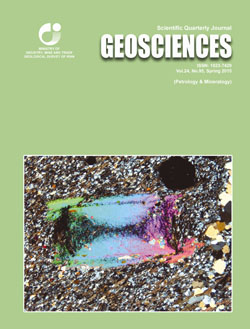Document Type : Original Research Paper
Authors
1 M.Sc. Student, Department of Geology, Tarbiat Modares University, Tehran, Iran
2 Associate Professor, Department of Geology, Tarbiat Modares University, Tehran, Iran
3 Assistant Professor, Department of Geology, Tarbiat Modares University, Tehran, Iran
Abstract
The Bashkand iron deposit is located in 16 km southwest of Soltanieh, in Central Iran Structural Zone. The rock units in the area include alternations of metamorphosed sedimentary rocks of the Kahar Formation, Khorramdarreh granite and an andesitic dike. The major alteration types are argillic, potassic, chloritic, sericitic and quartz-carbonatic in composition. N30-50W trend and S30-50W dip mineralization conforms primary bedding, foliation of phyllites as well as parallel faults. Mineralogical paragenesis includes: 1) Grossularite, pyroxene, idocrase; 2) Andradite, pyroxene, forsterite, phlogopite, magnetite; 3) Tremolite, serpentine, epidote, talc, biotite, magnetite, specularite and sulfides, and they have been cut by quartz-carbonate veins. The presence of magnetite synchronous with quartz and feldspar in the intrusive body, unconformity in behavior pattern of Fe2O3 with SiO2 and Al2O3, and its conformity with other major oxides as well as Cu and Zn, similarity of REE pattern in the ore, the intrusive body and skarnized host rocks as well as no similarity with the less altered host rocks, are the signs of sourcing ore from the intrusive-deriven fluids. Mixing of these fluids with meteoric water together with increasing in oxygen fugacity in the retrograde metasomatism stage led to ore mineralization.
Keywords

